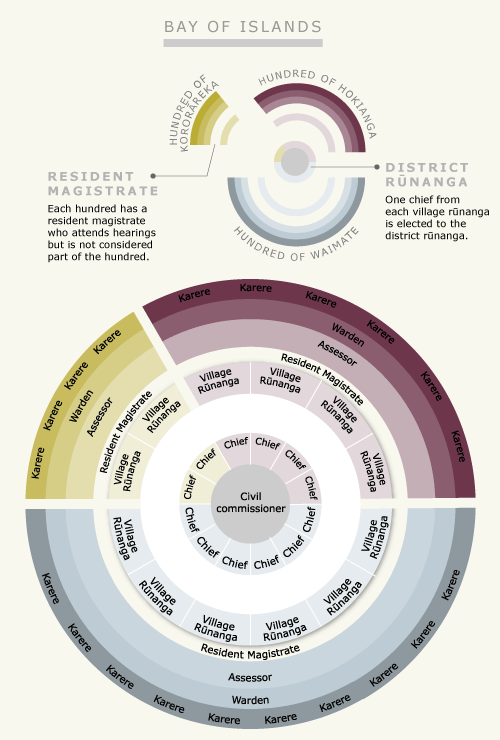
I te tau 1861, ka whakatauhia e Kāwana Grey te pūnaha rūnanga. I whakarāpopoto a J.E. Gorst: 'Ka wāwāhia te whenua ātea o ngā tāngata whenua ki ngā Rohe e rua tekau, ā, kia tirohia iho ia rohe e tētahi Kaikōmihana Ingarihi. Ka whakatakiwātia hoki ngā rohe kia ono ngā Rau takiwā, ā, mā ia takiwā e kōwhiri kia rua ngā kaiwhakawā Māori, kia kotahi te wātene, kia rima ngā pirihimana. Ka utua ēnei āpiha e te Kāwanatanga; kaiwhakawā mai i te £30 pauna ki te £50 pauna i te tau; wātene e £30; pirihimana £10, tae atu ki te hūtu i ia tau. Mā ngā kaiwhakawā tokorua o ia Rau e tū ai te Rūnanga ā-Rohe e tirohia ana e te Kaikōmihana ā-Motu' (J. E. Gorst, The Maori king. Ōtautahi: Kiwi, 1999 (i tānga tuatahitia i te tau 1864), wh. 134). Hei te whakatinanatanga, he nui ngā rerekētanga ka mutu ko te tauira kei runga ake nei he mea tango mai i tētahi pūrongo kāwanatanga mō te Pē o te Whairangi.
Te whakamahi i tēnei tūemi
Te Ara - The Encyclopedia of New Zealand
This item has been provided for private study purposes (such as school projects, family and local history research) and any published reproduction (print or electronic) may infringe copyright law. It is the responsibility of the user of any material to obtain clearance from the copyright holder.
Source: Lindsay Cox, Kotahitanga: the search for Maori political unity. Auckland: Oxford University Press, 1993







Tāpiritia te tākupu hou